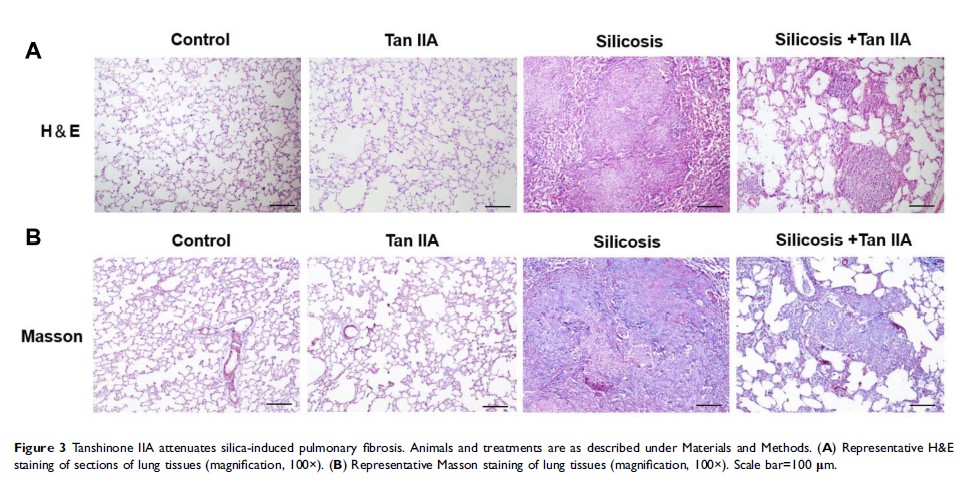9 1 2 3 6
论文已发表
注册即可获取德孚的最新动态
IF 收录期刊
- 2.6 Breast Cancer (Dove Med Press)
- 3.9 Clin Epidemiol
- 3.3 Cancer Manag Res
- 3.9 Infect Drug Resist
- 3.6 Clin Interv Aging
- 4.8 Drug Des Dev Ther
- 2.8 Int J Chronic Obstr
- 8.0 Int J Nanomed
- 2.3 Int J Women's Health
- 3.2 Neuropsych Dis Treat
- 4.0 OncoTargets Ther
- 2.2 Patient Prefer Adher
- 2.8 Ther Clin Risk Manag
- 2.7 J Pain Res
- 3.3 Diabet Metab Synd Ob
- 4.3 Psychol Res Behav Ma
- 3.4 Nat Sci Sleep
- 1.9 Pharmgenomics Pers Med
- 3.5 Risk Manag Healthc Policy
- 4.5 J Inflamm Res
- 2.3 Int J Gen Med
- 4.1 J Hepatocell Carcinoma
- 3.2 J Asthma Allergy
- 2.3 Clin Cosmet Investig Dermatol
- 3.3 J Multidiscip Healthc

丹参酮 IIA 通过 TGF-β1/Smad 信号通路抑制、NOX4 抑制和 Nrf2/ARE 信号通路激活在矽肺大鼠模型中的保护作用
Authors Feng F, Cheng P, Zhang H, Li N, Qi Y, Wang H, Wang Y, Wang W
Received 10 September 2019
Accepted for publication 14 November 2019
Published 18 December 2019 Volume 2019:13 Pages 4275—4290
DOI https://doi.org/10.2147/DDDT.S230572
Checked for plagiarism Yes
Review by Single-blind
Peer reviewer comments 2
Editor who approved publication: Professor Manfred Ogris
Purpose: Silicosis is an occupational disease caused by inhalation of silica and there are no effective drugs to treat this disease. Tanshinone IIA (Tan IIA), a traditional natural component, has been reported to possess anti-inflammatory, antioxidant, and anti-fibrotic properties. The current study’s purpose was to examine Tan IIA’s protective effects against silica-induced pulmonary fibrosis and to explore the underlying mechanisms.
Methods: 48 male SD rats were randomly divided into four groups (n=12): i) Control group; ii) Silicosis group; iii) Tan IIA group; iv) Silicosis +Tan IIA group. Two days after modeling, the rats of Tan IIA group and Silicosis +Tan IIA group were given intraperitoneal administration 25 mg/kg/d Tan IIA for 40 days. Then, the four groups of rats were sacrificed and the lung inflammatory responses were measured by ELISA, lung damage and fibrosis were analyzed by hematoxylin and eosin (H&E) staining and Masson staining, the expression levels of collagen I, fibronectin and α-smooth muscle actin (α-SMA) were measured by immunohistochemistry. The markers of oxidative stress were measured by commercial kits, and the activity of the TGF-β1/Smad and NOX4, Nrf2/ARE signaling pathways were measured by RT-PCR and Western blotting.
Results: The silica-induced pulmonary inflammtory responses, structural damage and fibrosis were significantly attenuated by Tan IIA treatment. In addition, treatment with Tan IIA decreased collagen I, fibronectin and α-SMA expression, and inhibited TGF-β1/Smad signaling in the lung tissue. The upregulated levels of oxidative stress markers in silicosis rats were also markedly restored following Tan IIA treatment. Furthermore, treatment with Tan IIA reduced NOX4 expression and enhanced activation of the Nrf2/ARE pathway in the lung tissue of silicosis rats.
Conclusion: These findings suggest that Tan IIA may protect lung from silica damage via the suppression of TGF-β1/Smad signaling, inhibition of NOX4 expression and activation of the Nrf2/ARE pathway.
Keywords: silicosis, tanshinone IIA, TGF-β1/Smad, NOX4, Nrf2/ARE
